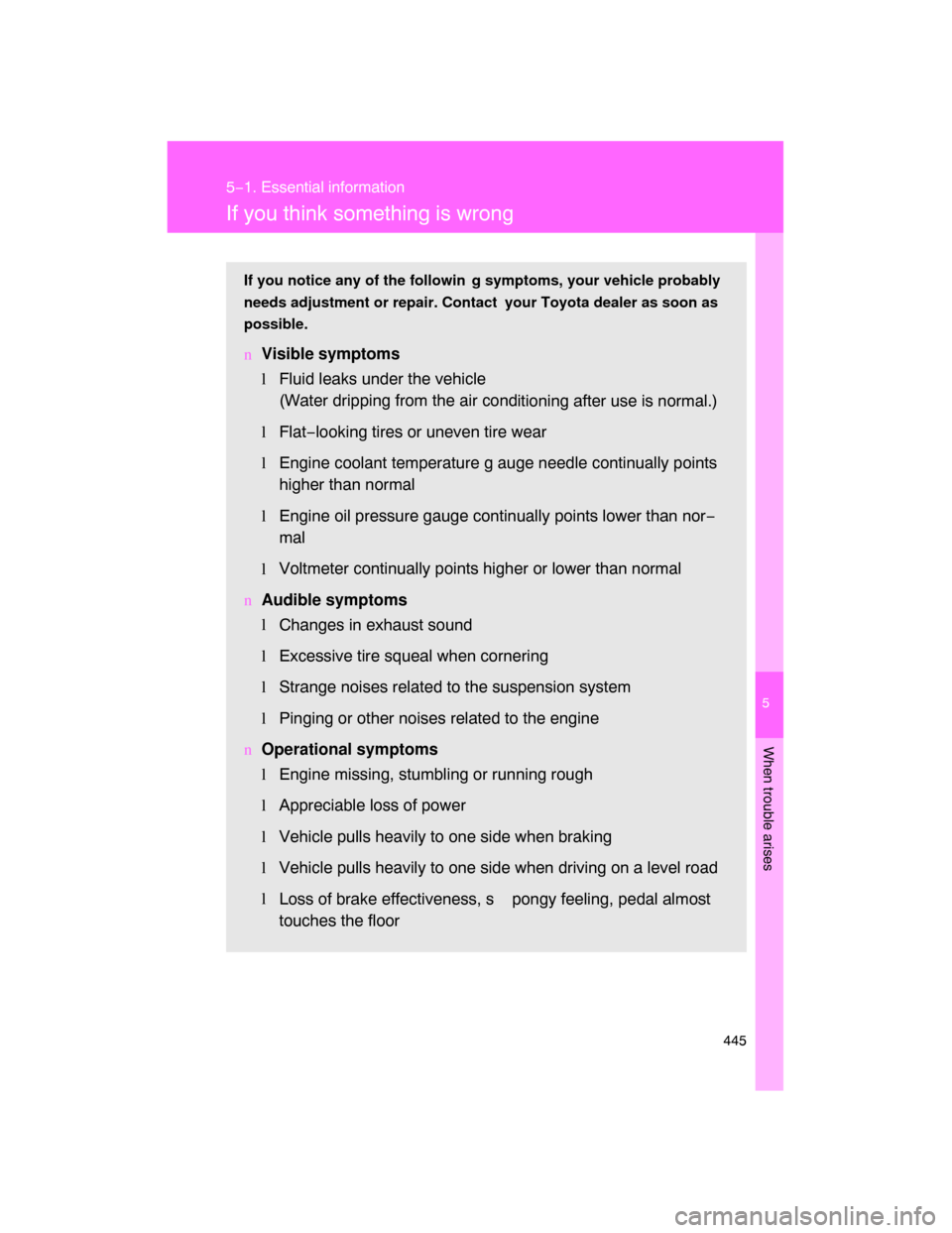Page 439 of 531

5
When trouble arises
445
5−1. Essential information
If you think something is wrong
If you notice any of the followin g symptoms, your vehicle probably
needs adjustment or repair. Contact your Toyota dealer as soon as
possible.
nVisible symptoms
lFluid leaks under the vehicle
(Water dripping from the air cond
itioning after use is normal.)
lFlat−looking tires or uneven tire wear
lEngine coolant temperature g auge needle continually points
higher than normal
lEngine oil pressure gauge continually points lower than nor−
mal
lVoltmeter continually points higher or lower than normal
n
Audible symptoms
l
Changes in exhaust sound
lExcessive tire squeal when cornering
l
Strange noises related to the suspension system
l
Pinging or other noises related to the engine
nOperational symptoms
l
Engine missing, stumbling or running rough
l
Appreciable loss of power
lVehicle pulls heavily to one side when braking
l
Vehicle pulls heavily to one side when driving on a level road
l
Loss of brake effectiveness, s pongy feeling, pedal almost
touches the floor
Page 448 of 531

454 5−2. Steps to take in an emergency
nIf the malfunction indicator lamp comes on while driving
The malfunction indicator lamp will come on if the fuel tank becomes com−
pletely empty. If the fuel tank is empty, refuel the vehicle immediately. The
malfunction indicator lamp will go off after several trips.
If the malfunction indicator lamp does not go off, contact your Toyota dealer
as soon as possible.
nFront passenger detection sensor and passenger seat belt reminder
lIf luggage is placed on the front passenger seat, the front passenger
detection sensor may cause the warning light to flash, even if a passen−
ger is not sitting in the seat.
lIf a cushion is placed on the seat, the sensor may not detect a passen−
ger, and the warning light may not operate properly.
nSRS warning light
This warning light system monitors the following:
lThe airbag sensor assembly
lFront airbag sensors
lThe curtain shield airbag sensors
lThe side and curtain shield airbag sensors
lThe seat belt buckle switches
lThe driver ’s seat position sensor
lThe inflators
lThe interconnecting wiring and power sources
lThe front passenger occupant classification ECU
l“AIR BAG ON” and “AIR BAG OFF” indicator lights
lThe seatbelt pretensioners
lThe roll sensing of curtain shield airbags off indicator light
nChanging the engine oil
l
Make sure to reset oil change system
Page 456 of 531
462 5−2. Steps to take in an emergency
nResetting the tire pressure warning data
After adjusting the tire inflation pressure, be sure to initialize the data.
(P. 393)
If the message remains on, the system may have malfunctioned. Have the
vehicle inspected by your Toyota dealer as soon as possible.
nWarning messages in the cruise control mode
In the following instances, there is a possibility that the approach warning will
not illuminate even when vehicle−to−vehicle distance is closing.
lWhen the speed of the vehicle ahead matches or exceeds your vehicle’s
speed.
lWhen the vehicle ahead is traveling at an extremely slow speed.
lImmediately after the cruise control speed has been set.
l
At the instant the accelerator is applied.
NOTICE
nEngine oil maintenance message
The warning message is based on the projected driving range after engine
oil maintenance message is reset.
The system does not monitor the purity of the engine oil.
Page 490 of 531
497
6−1. Specifications
6
Vehicle specifications
Lubrication system
Oil viscosity:
l
The 0W portion of the oil viscosity rating indicates the characteristic
of the oil which allows cold startab ility. Oils with a lower value before
the W allow for easier starting of the engine in cold weather.
lThe 20 in 0W−20 indicates the oil viscosity when the oil is as its oper−
ating temperature. An oil with a higher viscosity may be better suited
if the vehicle is operated at high
speeds, or under extreme load con−
dition.
Oil capacity drain and
refill
(Reference)
with filter
without filter7.4 qt. (7.0 L, 6.2 lmp.qt.)
7.0 qt. (6.6 L, 5.8 lmp.qt.)
Oil grade
ILSAC multigrade engine oil
Recommended oil
viscosity
Use Toyota approved “Toyota Genuine Motor Oil”
or equivalent to satisfy the above grade and vis−
cosity.
Outside temperature
Page 493 of 531
500 6−1. Specifications
Automatic transmission
Transfer
Brakes
*1: Minimum pedal clearance when depressed with a force of 110 lbf (490 N, 50
kgf) while the engine is running.
*2: Parking brake pedal travel when pulled with a force of 45 lbf (200 N, 20 kgf).
Fluid
capacityWithout oil cooler11.5 qt. (10.9 L, 9.6 Imp.qt.)
With oil cooler
11.7 qt. (11.1 L, 9.8 Imp.qt.)
Fluid type Toyota Genuine ATF WS
NOTICE
Using transmission fluid other than “Toyota Genuine ATF WS” may cause
deterioration in shift quality, locking up of your transmission accompanied by
vibration, and ultimately damage the transmission of your vehicle.
Oil capacity
1.53 qt. (1.45 L, 1.28 lmp.qt.)
Oil type
Gear oil API GL−5
Recommended oil viscosity
SAE75W−90
Pedal clearance
*13.62 in. (92 mm) Min.
Pedal free play 0.04 0.24 in. (1.0
6.0 mm)
Brake pad wear limit
0.04 in. (1.0 mm)
Parking brake lining wear limit
0.04 in. (1.0 mm)
Parking brake adjustment
*25 7 clicks
Fluid type
SAE J1703 or FMVSS No. 116 DOT 3
Page 505 of 531

512 6−1. Specifications
Warning: The temperature grades for this tire are established for a
tire that is properly inflated and not overloaded.
Excessive speed, underinflation, or
excessive loading, either sepa−
rately or in combination, can cause heat buildup and possible tire fail−
ure.
Glossary of tire terminology
Tire related term Meaning
Cold tire inflation
pressureTire pressure when the vehicle has been
parked for three hours or more, or has not
been driven more than 1 mile or 1.5 km under
that condition
Maximum inflation
pressureThe maximum cold inflated pressure to which a
tire may be inflated, shown on the sidewall of
the tire
Recommended
inflation pressureCold tire inflation pressure recommended by a
manufacturer.
Accessory weightThe combined weight (in excess of those stan−
dard items which may be replaced) of trans−
mission, power steering, power brakes, power
windows, power seats, radio and heater, to the
extent that these items are available as factory−
installed equipment (whether installed or not)
Curb weightThe weight of a motor vehicle with standard
equipment, including the maximum capacity of
fuel, oil and coolant, and if so equipped, air
conditioning and additional weight optional
engine
Maximum loaded
vehicle weight
The sum of:
(a) Curb weight
(b) Accessory weight
(c) Vehicle capacity weight
(d) Production options weight
Page 516 of 531
523
6
Vehicle specifications
6−3. Initialization
Items to initialize
ItemWhen to initialize Reference
Engine oil mainte−
nance dataAfter changing engine oil P. 380
Tire pressure warning
system�When rotating the tires on vehicles
differing with front and rear tire infla−
tion pressures.
�When changing the tire inflation
pressure by changing traveling
speed or load weight, etc.
�When changing the tire size.
P. 393
The following items must be init ialized for normal system operation
in cases such as after the battery is
reconnected, or maintenance is
performed on the vehicle.
Page 523 of 531

532
Alphabetical index
Doors
Back door ................................ 48
Side door ................................. 43
Side mirrors ............................. 80
Driver’s seat belt reminder
light ......................................... 452
Driving
Break−in tips .......................... 141
Correct posture ..................... 100
Off−road precautions ............. 209
Procedures ............................ 140
Winter driving tips.................. 222
Driving position memory........... 62
Electronic key
If your electronic key
battery is discharged... 410, 481
Emergency, in case of
If a warning message is
displayed............................. 460
If the electronic key does
not operate properly............ 481
If the engine will not start ...... 476
If the shift lever cannot be
shifted from P...................... 478
If the vehicle has discharged
battery ................................ 484
If the warning buzzer
sounds ................................ 449
If the warning light turns on ... 449
If you cannot operate back
door opener ........................ 480
If you have a flat tire ............. 463
If you lose your keys ............. 479
If you think something is
wrong .................................. 445
If your vehicle becomes
stuck ................................... 491
If your vehicle needs to be
towed .................................. 440
If your vehicle overheats ....... 488Engine
Compartment ........................ 375
Engine switch ........................ 149
Hood ..................................... 374
How to start the engine ......... 149
Identification number............. 495
If the engine will not start ...... 476
Ignition switch ....................... 149
Overheating .......................... 488
Engine coolant
Capacity ................................ 498
Checking ............................... 382
Preparing and checking
before winter ....................... 222
Engine coolant temperature
gauge ...................................... 160
Engine immobilizer system ...... 93
Engine oil
Capacity ................................ 497
Checking ............................... 377
Preparing and checking
before winter ....................... 222
Engine oil maintenance
data ......................................... 380
Engine switch........................... 149
Event data recorder ................. 447
First�aid kit holder ................... 351
Floor mat .................................. 349
Fluid
Brake..................................... 384
Power steering ...................... 386
Washer.................................. 390
Fog lights
Replacing light bulbs ............. 426
Switch ................................... 172
Wattage................................. 503
Four�wheel drive system......... 190
Front fog lights
Replacing light bulbs ............. 426
Switch ................................... 172
E
F